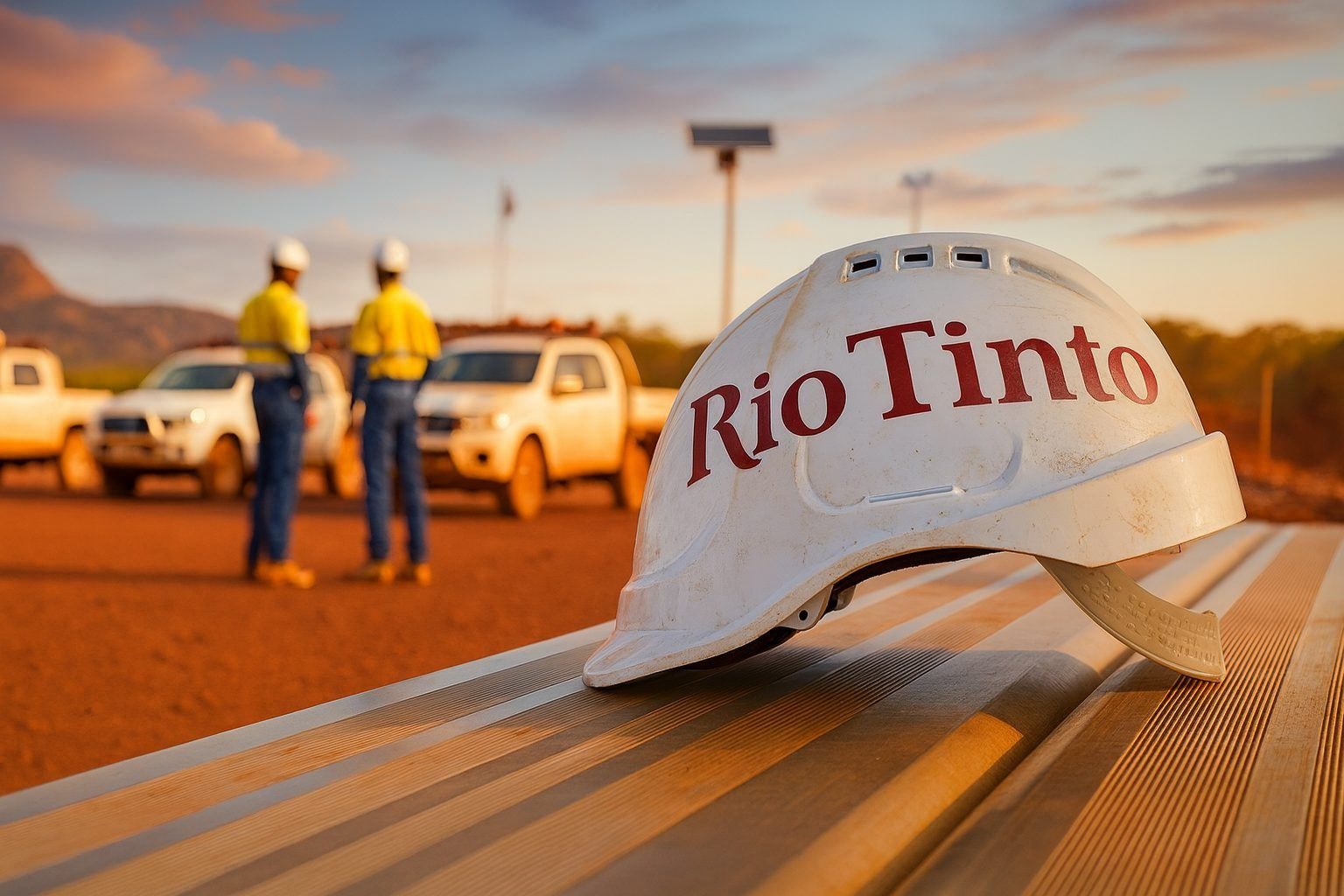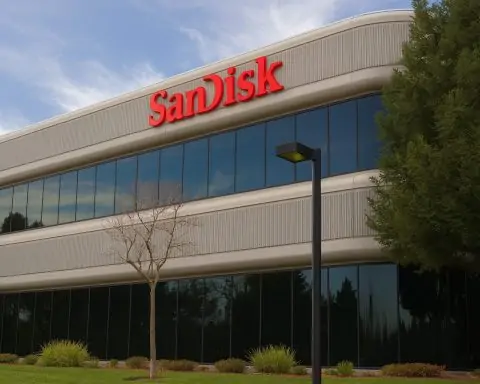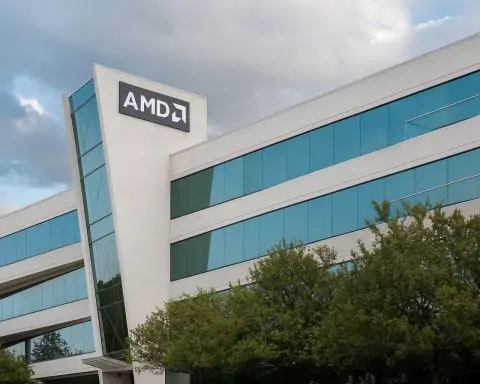London / Sydney – 27 November 2025 — Rio Tinto plc (NYSE: RIO; LON: RIO; ASX: RIO) is in focus today after multiple outlets reported that the miner is preparing to sell its U.S. boron operations in California in a deal that could be worth up to $2 billion, even as its New York–listed shares trade close to a 52‑week high and London-listed stock slips with the wider FTSE 100 mining sector. [1]
Rio Tinto Prepares Sale of U.S. Boron Business
According to Bloomberg reporting picked up by several financial news outlets, Rio Tinto is seeking buyers for its boron-producing assets in California, with a formal sales process expected to begin within the next two weeks. [2]
Coverage from Investing.com and MINING.COM indicates that the proposed package includes: [3]
- The historic open‑pit Boron mine and processing plant in the Mojave Desert town of Boron
- A refinery and shipping facility at the Port of Los Angeles
- The Owens Lake mining operation near the Sierra Nevada
Taken together, these California operations are estimated to supply around 30% of global boron demand, underscoring the strategic importance of any divestment. [4]
Reports say Rio has hired UBS Group AG and JPMorgan Chase & Co. to advise on the transaction, which market commentators expect could be valued at up to $2 billion depending on the final structure and bidders. [5]
Bloomberg’s coverage emphasises that potential buyers are likely to include private equity funds and chemical producers, rather than other diversified mining houses, reflecting the specialised nature of the assets and the growing interest of financial sponsors in critical-mineral infrastructure. [6]
Why Boron and These Assets Matter
Boron has shifted from an obscure industrial input to a listed U.S. critical mineral, thanks to its role in technologies spanning fertilisers, glass and ceramics, fibreglass insulation, high‑strength steel alloys, advanced magnets and certain defence applications. [7]
Key points about the California boron business:
- The Boron mine has been in operation for about a century and, according to MINING.COM, still has reserves that could support production into the early 2040s. [8]
- Rio’s California operations are widely cited as supplying around one‑third of the world’s boron, giving them outsized influence over pricing and downstream availability. [9]
- AInvest notes that the U.S. government’s decision to place boron on its 2025 Critical Minerals List has heightened policy and investor attention on projects that can support domestic supply-chain security. [10]
For Washington, the sale will be watched closely: any new owner will be taking control of one of the few large-scale domestic boron hubs at a time when the U.S. is trying to reduce dependency on Chinese processing capacity. [11]
Strategic Shift Under New CEO Simon Trott
Today’s boron headlines are best understood in the context of Rio Tinto’s ongoing portfolio reshaping under new chief executive Simon Trott.
In August, Trott announced a three‑unit revamp, reorganising Rio into core divisions focused on iron ore; aluminium plus lithium; and copper, while moving borates and iron & titanium operations into the portfolio of Chief Commercial Officer Bold Baatar for strategic review. [12]
Earlier Reuters reporting revealed that Rio has also been considering a sale of its titanium business due to weak returns, with analysts describing borates and titanium as “low‑hanging fruit” for portfolio optimisation. [13]
Taken together, the potential boron divestment and the titanium review suggest that Trott is doubling down on a strategy of:
- Concentrating capital on high‑margin iron ore, copper and aluminium
- Trimming more specialised industrial minerals where Rio lacks structural advantage
- Freeing up balance sheet capacity for energy‑transition projects and new critical‑mineral ventures
The California sale therefore looks less like a one‑off disposal and more like the first tangible outcome of the strategic review Trott signalled in late summer.
Market Reaction: RIO Near 52‑Week High in New York, Softer in London
On the NYSE, Rio Tinto’s American depositary receipts (ADR) traded around $72.20 today, modestly higher on the session and close to a 52‑week high of $73.76. The 52‑week low stands near $51.67, highlighting the stock’s strong run over 2025. [14]
DefenseWorld, citing recent regulatory filings, notes that Advisors Asset Management Inc. increased its Rio Tinto position by 3.8% in Q2, now holding just over 91,000 shares worth roughly $5.3 million, while other institutional investors have been selectively adding small positions. [15]
Balance‑sheet metrics also remain conservative by big-miner standards, with a debt‑to‑equity ratio around 0.37 and current and quick ratios above 1.0, giving Rio flexibility to recycle capital from non‑core assets into growth projects or shareholder returns. [16]
In London, however, the mood was more cautious. The latest Reuters market wrap shows the FTSE 100 down about 0.3%, with the industrial miners sub‑index off roughly 1.2%. Both Rio Tinto (RIO.L) and Anglo American were down more than 1.5%, weighed by softer commodities and investor digestion of the U.K. government’s tax‑raising budget. [17]
That divergence — stronger ADRs in the U.S., weaker London line — suggests U.S. investors may be focusing more on the option value of portfolio simplification, while U.K. traders are reacting to macro and sector-wide headwinds.
Kalkine Media also highlights that RIO has been trading near the top of its recent range on the NYSE, drawing attention within the Basic Materials space, particularly as congressional trading disclosures and institutional flows shine a spotlight on the name. [18]
How the Sale Fits Into the Critical-Minerals Story
The boron sale is not just a corporate housekeeping exercise; it slots into a broader critical‑minerals narrative playing out across U.S. and Australian markets.
An AInvest analysis frames Rio’s divestment as a “pivotal moment” for the global boron supply chain, pointing out that: [19]
- The California assets being marketed by Rio could be valued at up to $2 billion
- Boron’s designation as a U.S. critical mineral has increased policy support for alternative suppliers
- Developers like 5E Advanced Materials, which is seeking about $20 million in federal support for its Fort Cady boron project, stand to benefit from any reshuffling of supply. [20]
For potential buyers, the deal offers:
- Immediate scale in a market where high‑grade boron deposits are relatively rare
- Integration opportunities across fertilisers, speciality glass, EV components and defence materials
- Strategic leverage as governments look to de‑risk their supply chains
For Rio, the move could unlock cash while reducing exposure to smaller, more specialised product lines that sit outside its iron ore–copper–aluminium core.
Regulatory and Policy Backdrop: From APRA to Green Laws
The Rio story today is also intertwined with evolving regulatory settings in its key markets:
- In Australia, a detailed TS2.Tech explainer on the Australian Prudential Regulation Authority’s new debt‑to‑income cap on home loans notes Rio’s U.S. asset sale as one of several developments “shaking” local equity sentiment, alongside a multi‑billion‑dollar takeover bid for National Storage REIT. TechStock²
- Separate coverage from Kalkine Media outlines how a Greens–Labor environmental reform deal is tightening federal oversight on major resource projects under changes to the EPBC Act, with Rio Tinto cited as one of the ASX 200 miners needing to navigate tougher national standards while also benefiting from streamlined approvals for critical minerals and renewables. [21]
Another Kalkine article on abandoned mines and safety highlights Rio Tinto among the ASX 200 miners operating in regions with significant historical mine activity. It stresses the importance of community safety, mine‑mapping and rehabilitation, areas that are increasingly important to investors as ESG screens become more demanding. [22]
All of these threads — macro‑prudential housing rules, environmental law reform, and safety expectations — form part of the regulatory backdrop against which Rio’s portfolio decisions will be judged.
ESG and Community Impact: Gender‑Violence Support in Focus
On the social impact front, Rio Tinto is also in the news today for its role in campaigns against gender‑based violence.
A feature in aluminium industry outlet AlCircle highlights that, during this year’s 16 Days of Activism Against Gender‑Based Violence, Rio has committed US$400,000 to support 15 organisations across Canada that provide shelter, counselling, education and other crucial services to women, children and 2SLGBTQ+ survivors. That takes the company’s total contributions to such partners to about US$2.335 million since 2020. [23]
One long‑standing partner, SOS violence conjugale, has reportedly used funding to modernise tools and protocols that help victims access information and escape abusive situations more safely. [24]
While this work is being applauded in some quarters, Rio continues to face scrutiny for its historical relationship with Indigenous communities — notably around the destruction of rock shelters at Juukan Gorge in Western Australia and subsequent commitments to modernise agreements with Aboriginal groups. A Reuters piece earlier this year reported that some Indigenous leaders believe the company has yet to fully deliver on those pledges. [25]
For investors, today’s social-impact coverage is a reminder that ESG performance is multi‑dimensional: portfolio decisions, project approvals and community relationships all feed into Rio’s long‑term licence to operate.
Political and Insider‑Style Disclosures
Adding to the flow of RIO‑related headlines, congressional trading disclosures in the U.S. show that Representative Lisa C. McClain (R‑Michigan) recently sold a small position in Rio Tinto, valued in the low‑thousands of dollars, as part of a broader series of stock disposals across multiple companies. [26]
Kalkine Media notes that this series of modest trades, combined with ongoing institutional position‑tweaking, has drawn some extra attention to Basic Materials stocks such as Rio, but the filing itself contains no commentary on the company’s fundamentals. [27]
Such disclosures are increasingly tracked by retail investors, but they are typically too small and too general to serve as a clear trading signal on their own.
What to Watch Next for Rio Tinto (RIO)
For market participants following Rio Tinto into December and 2026, key watch‑points include:
- Formal launch of the boron sale process
- Bloomberg, MINING.COM and Investing.com all indicate that marketing of the asset package could begin within the next couple of weeks, with UBS and JPMorgan running the process. [28]
- A successful deal near the rumoured $2 billion valuation would give Rio additional flexibility on capital allocation — whether that means funding new projects, accelerating decarbonisation investments, or returning cash to shareholders.
- Buyer universe and competitive tension
- Private equity and specialty chemical producers are seen as the likeliest bidders, but the sector‑wide push to secure boron supply — including government‑backed projects like 5E Advanced Materials’ Fort Cady — could create surprise interest from strategic buyers. [29]
- Further portfolio moves under Trott
- With titanium already under consideration for divestment and borates now effectively in play, investors will be watching for additional non‑core disposals and for updates on major growth projects in iron ore, copper, aluminium and lithium. [30]
- Regulatory and ESG developments
- Implementation of Australia’s new environmental reforms, evolving critical‑mineral policies in the U.S., and ongoing community engagement with Indigenous and local stakeholders will all feed into how Rio Tinto’s risk profile is perceived. [31]
Bottom Line
As of 27 November 2025, Rio Tinto is simultaneously:
- Reshaping its portfolio by preparing to sell a century‑old boron business that still supplies a large chunk of the world’s demand
- Trading near recent highs on the NYSE, even as London shares soften with the broader FTSE mining cohort
- Navigating a shifting policy and ESG landscape, from critical‑mineral strategies to environmental law reforms and community‑safety debates
- Stepping up social‑impact initiatives, particularly around support for survivors of gender‑based violence in Canada
For investors and analysts, the U.S. boron sale is likely to be the headline catalyst over the next few months, but its implications sit within a much larger story about how Rio Tinto wants to position itself for the energy transition, critical‑minerals security and long‑term social licence.
This article is for informational purposes only and does not constitute investment advice. Always do your own research or consult a licensed financial adviser before making investment decisions.
References
1. m.ph.investing.com, 2. www.bloomberg.com, 3. m.ph.investing.com, 4. m.ph.investing.com, 5. m.ph.investing.com, 6. www.bloomberg.com, 7. www.mining.com, 8. www.mining.com, 9. www.mining.com, 10. www.ainvest.com, 11. www.ainvest.com, 12. www.reuters.com, 13. www.reuters.com, 14. www.defenseworld.net, 15. www.defenseworld.net, 16. www.defenseworld.net, 17. www.reuters.com, 18. kalkinemedia.com, 19. www.ainvest.com, 20. www.reuters.com, 21. kalkinemedia.com, 22. kalkinemedia.com, 23. www.alcircle.com, 24. www.alcircle.com, 25. www.reuters.com, 26. www.marketbeat.com, 27. kalkinemedia.com, 28. www.bloomberg.com, 29. www.reuters.com, 30. www.reuters.com, 31. kalkinemedia.com







